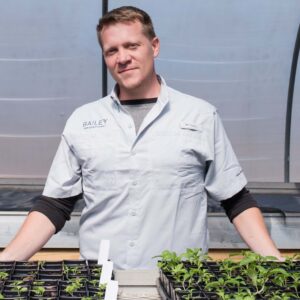Behind the scenes at First Editions®, we have a passionate group of people who work to provide you with the best performing plants. They do the work, so you don’t have to. Today, we’re introducing you to one of those people. David Roberts is the General Manager and Lead Plant Breeder at Bailey Innovations. We sat down and asked him about his role, his favorite First Editions® plants, and his best advice for the home gardener.

I’m the General Manager and Lead Plant Breeder at Bailey Innovations, a plant breeding facility that works on developing, studying, and testing new introductions for the First Editions® Shrubs & Trees collection. I’ve been in this role for the past five years.
I manage the day-to-day operations of Bailey Innovations, located just outside of Athens, GA. Some of my responsibilities include hybridizing plants, sowing seed, making selections, propagating those selections, and collecting data from those trials. All of this is done to find the best new plant from the thousands of seedlings that we may start from initially. Our goal is to bring to market something that is unique, different, and better than what already exists, so we take our time to do it right.
I received my bachelor’s and my master’s degrees in horticultural science from North Carolina State University with a concentration in ornamental plant breeding. During that time, I studied under Dr. Tom Ranney and Dr. Dennis Werner, where we actively bred ornamental shrubs and trees. That program was one of the best university breeding programs in the country, which was an incredible opportunity and a great introduction to this type of work. I was very fortunate to secure a job with Bailey Innovations before graduating from my master’s program, and I’m very grateful they were willing to take a chance on someone fresh out of school.
That’s a tough one! I’m very fond of all of the plants we’ve introduced over the last few years, but if I had to pick just one, it would be Lunar Magic® Crapemyrtle. It’s got incredibly dark foliage, pure white blooms, and it’s a flowering machine! It has great mildew resistance making it easy for our growers and home gardeners to manage, while its ability to rebloom will provide color all summer long. Lunar Magic® was the first crapemyrtle I ever trialed, and they even let me name it!
Disease resistance is one of the most important traits we select for in all the plants we work with. In bigleaf hydrangea and crapemyrtle breeding, we have a zero-tolerance policy for mildew. By providing improved disease resistance, end-users don’t need to worry about treating their plants in the landscape. No one wants to stress over the health of their plants, so we do whatever we can to help make your lives easier.
Say no to “crape murder!” In the South, many home gardeners and landscape professionals alike have an unfortunate tendency to severely prune back their crapemyrtle, a practice we refer to as “crape murder.” This involves the removal of large limbs and branches from a crapemyrtle, sometimes leaving nothing but a trunk. The thinking behind this is that by removing old growth, the plant will produce a lot of new growth, which is what these plants flower on. Unfortunately, this practice can result in serious problems with the shrub or tree’s structure and health. Instead of taking a chainsaw to a mature crapemyrtle, try selectively pruning and removing smaller branches. By making small refinements, you’ll have a healthy plant that flowers strongly and looks much more natural in the landscape.
Watch this video to learn how to deadhead your First Editions® Magic series of crapemyrtle!
I’m a huge fan of Flip Side® Chastetree. It’s one of the most unique chastetree you’ll find on the market. Growing to a height of 6-8′, it stays much lower than other varieties can get. A classic like ‘Shoal Creek’ can get up to 15′ tall, so this is a big improvement for today’s landscape. Flip Side® also has a lovely, dusky purple coloration on the underside of its leaves, giving it a very unique appearance. Flip Side® is a great rebloomer, so it will flower readily throughout the summer, especially if you deadhead the spent blooms. Even though Flip Side® is a heavy bloomer and pollinator magnet, it’s also sterile, meaning you won’t have to worry about this selection becoming weedy or invasive.
I love traveling and trail running. Whether it’s in the U.S. or abroad, I love checking out botanic gardens, arboreta, and national parks, especially if they have nice trails. I also practice the art of bonsai, which is really just a different kind of containerized horticulture.